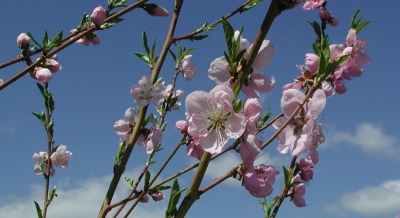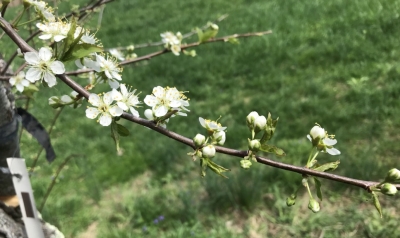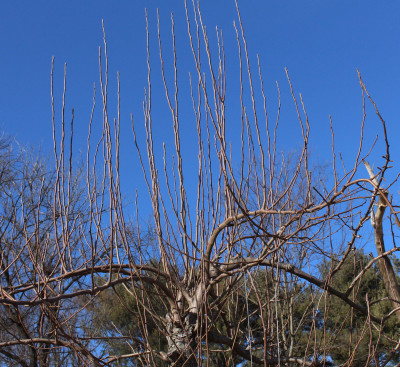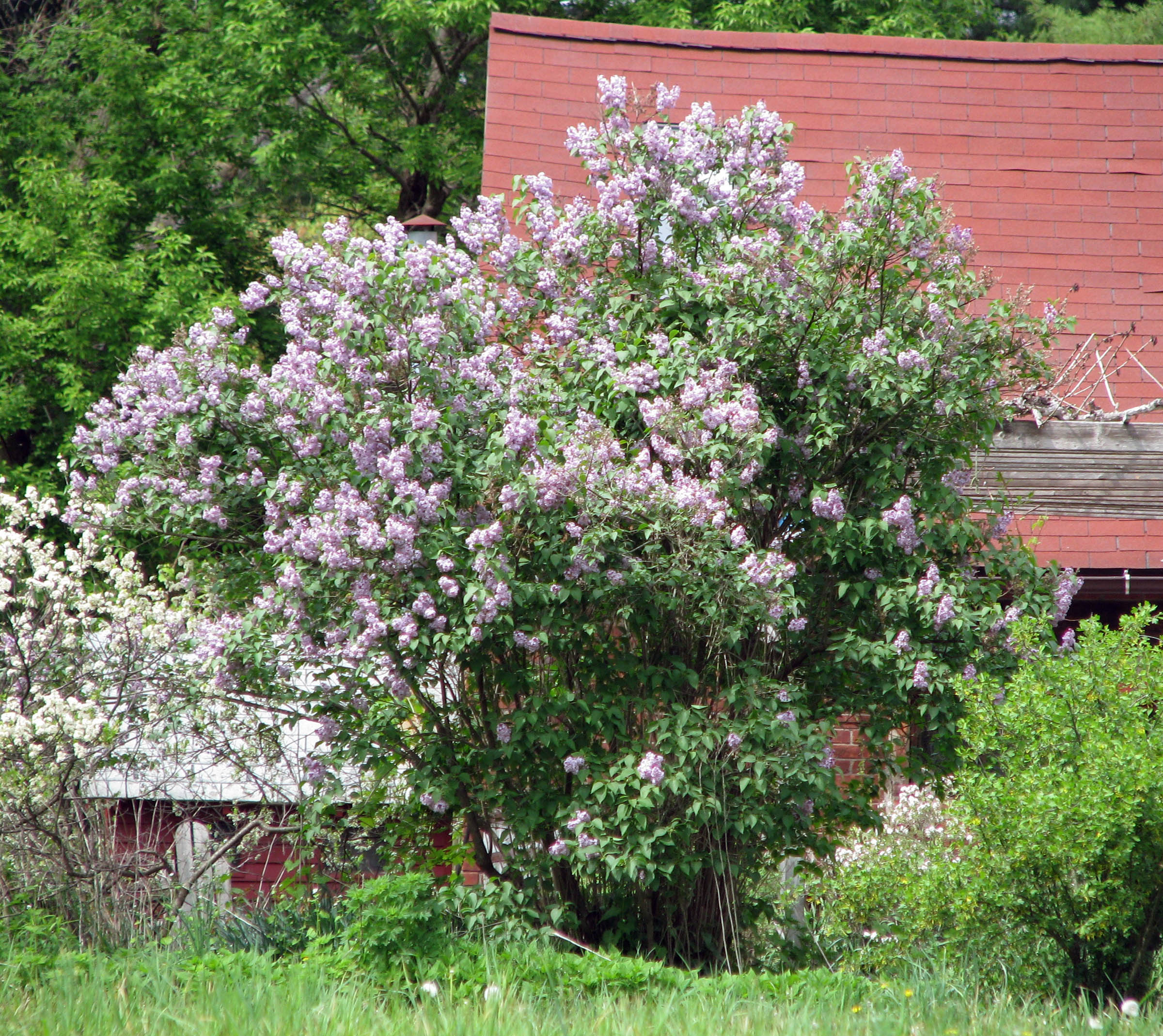Fruit Tree Pruning
The Why, and the Easiest
Following last week’s missive about pruning fruiting shrubs, I now move on to pruning my fruiting trees. Again, this is “dormant pruning.” Yes, even though the trees’ flower buds are about to burst or have already done so, their response will still, for a while longer, be that to dormant pruning. I mentioned flower buds, so these plants I’m pruning are mature, bearing plants. The objectives and, hence, pruning of a young tree are another ball game. As is renovative pruning, which is the pruning of long-neglected trees.
I mentioned flower buds, so these plants I’m pruning are mature, bearing plants. The objectives and, hence, pruning of a young tree are another ball game. As is renovative pruning, which is the pruning of long-neglected trees.
Most fruit trees need to be pruned (correctly) every year. Annual pruning keeps these trees healthy and keeps fruit within reach. This pruning also promotes year after year of good harvests (some fruit trees gravitate toward alternating years of feast and famine) and — most important — makes for the most luscious fruits.
With that said, as I’ve pointed out previously, a number of fruit trees can get by with little or no pruning, nothing more than thinning out congested branches, cutting back diseased branches to healthy wood, and removing root sprouts.
Among these easiest to prune fruit trees are persimmon, pawpaw, juneberry, jujube, quince, and medlar. (These are some of the uncommonly delectable fruits covered in my book Uncommon Fruits for Every Garden.) Trees such as juneberry and medlar are quite ornamental, so I also lop off or back wayward branches on these trees to keep them looking pretty.
Fruits Borne on New Shoots and/or 1-Year-Stems
The most straightforward approach to pruning those fruit trees that absolutely benefit from annual (correct) pruning is by grouping them according to their fruit-bearing habits.
Figs, for instance, are unique in being able to bear fruits on new, growing shoots.

Figlets on new growth
So the way to prune a fig tree — with caveats — is to lop back branches, which promotes new, fruit-bearing shoots. But not too, too far or the fruit will take too long to begin ripening. I prune branches of my potted or greenhouse Brown Turkey fig trees only as far back as their permanent trunks of a couple of feet or more in length.
Also, not necessarily all the stems should be pruned back on figs, because some varieties also — or only — bear fruit on one-year-old stems. My San Piero fig, for instance. I typically leave some one-year-old stems to bear an early crop, and drastically shorten others for the crop on new, growing shoots, which begins ripening later.
Peach and nectarine trees also bear on one-year-old stems, so are also pruned rather drastically. I shorten some branches to promote new shoot growth for next year’s harvest. I also remove some branches completely to prevent congestion, allowing branches to bask in sunlight, and breezes to dance among them. When finished, you should be able to throw a cat (figuratively) through the branches without touching them.
I shorten some branches to promote new shoot growth for next year’s harvest. I also remove some branches completely to prevent congestion, allowing branches to bask in sunlight, and breezes to dance among them. When finished, you should be able to throw a cat (figuratively) through the branches without touching them.
Fruits Borne on 1-Year + Older Stems
Fruit trees that bear their fruits on one-year-old as well as on older wood are the next grouping, and include plum, apricot, sweet, and tart cherry. The clusters of flower buds on branches of these trees are known as spurs. (Be careful not to put too much general meaning in “spur” because the word parades under a number of guises in the world of gardening.)

Clusters (spurs) of blossoms on plum
Pruning fruit trees removes some flower buds and potential fruits, which is all for the good because it lets the plant funnel more of its flavor-producing energy into fewer fruits so that those that remain are tastier and larger. Cherries, each of whose small fruits demand little energy, benefit the least of these fruits from such pruning so are the least pruned of the fruits in this category.
Apricot gets the most pruning in this group because its fruit spurs are borne on branches up to 3-years-old. That leaves plums, which get a moderate amount of pruning.
And Even Older Fruit-Bearing Stems
Apples and pears, the final grouping, are the most common tree fruits. Their individual branches each continue to bear flowers and fruits for many years.

Pear spur
Look at an older apple or pear branch and along it you see small, branching stems an inch or less long. These stem clusters are called — and I warned you — “spurs.”
Because their spurs live and bear for a decade or more, apple and pear trees require the least pruning of the fruit trees mentioned.
Then again, spurs do age, eventually becoming overcrowded and decrepit. So I thin out and shorten old spurs so that each has sufficient space and is periodically invigorated with stubby, new growth.

Thinning apple spurs
Exuberant, vertical shoots, known as watersprouts, often pop up on apple or pear branches. Mostly, they are unwanted because they’re not very fruitful and, left alone, will shade other parts of the tree. I cut these off right to their bases.

Pear watersprouts
Even better is to grab hold of watersprouts when you first notice them growing and rip them off with a quick downward pull. “When noticed,” in contrast to all the pruning I just wrote about, is not during the dormant season.



Lee, question for you: I am getting ready to spray my fruit trees (all planted in 2013) a la Michael Phillips, and I noticed some orange -ish cracks in the crotches of 2 of my plums. They were a bit crusty and I picked that off, and gave each area a good shot of Neem: I don’ t know what this is! Can you enlighten me and tell me what to do? The trees are growing like weeds and beautiful so I am a bit scared!
When Prunus species plants get bark damage they exude a thick, orangish goo that hardens. That’s probably what is on your plants, possibly from small cracks that occurred through winter.
Good morning Lee,
Thanks for the great practical advice and for sharing your knowledge. Im an avid gardener here in Winnipeg, Manitoba with a variety of fruit trees and shrubs in our yard. I refer to your pruning book often! We are slowly adapting to climate change and it seems our Zone is warming and longer.
After five years of growing fruit trees, I feel pruning remains the hardest concept. Part of this is just the greed of wanting a bigger tree with more fruit and part of it is conflicting information found on the internet and books.
This is a very concise and easy to use tutorial. Thanks Lee.
Can you add about pruning citrus? We have tangerine & orange trees.
These trees need little regular pruning, mostly just thinning out branches to let air and light within, and some shortening of stems to stimulate growth of younger stems. Of course, there’s a lot more detail in my book the PRUNING BOOK.
Or anything about raising mango or avocado? We have been watering both for years, and only this past year had a handful of mangos, maybe 10. Is it already time to prune, or leave them alone?
These trees need little regular pruning, mostly just thinning out branches to let air and light within, and some shortening of stems to stimulate growth of younger stems. Of course, there’s a lot more detail in my book the PRUNING BOOK.
Hi Lee, I’ve read uncommon fruit and am now tucking into a northeast gardeners year. Practical question for you. I have a north star sour cherry which is getting on in years and in the past year has some large branches with a fungus (black knot or brown rot I think). There is one particular cut that I need to make which will be a big one. My wife makes a great cherry pie and I don’t want to miss it on account of this pruning cut. The buds are swelling just now. Can I make the cut and eat my pie too? Or should I make smaller cuts, spray a bit until July when whatever fruit I get this year comes in and then cut into it. I already planted a replacement but want to get fruit from this one for the next couple of years until the heir comes of age. What do you recommend?
It’s hard to say without seeing the tree and the infection. If it’s a tarry mass, its black knot.If you spray, make sure the spray is listed for the particular disease your tree has.
I pruned my trees in the fall, and now the shoots are growing back up in the spring. I’m thinking whether to cut them again, although it’s summer, wait until autumn again?
Generally, it’s best to wait. But summer pruning is useful for getting rid of suckers, letting light in on fruit that need light to color up, etc. Dee my book THE PRUNING BOOK for stuff about summer pruning.
I have been pruning my apple trees for 42 yrs before they bud.
This year I couldn’t, and they all have leaves. Ok to prune now without too much damage? I want to cut the tall limbs going up, and some going out.
Pruning now, still early in the season is fine. The response should be pretty much the same to that if you pruned a month or more ago.